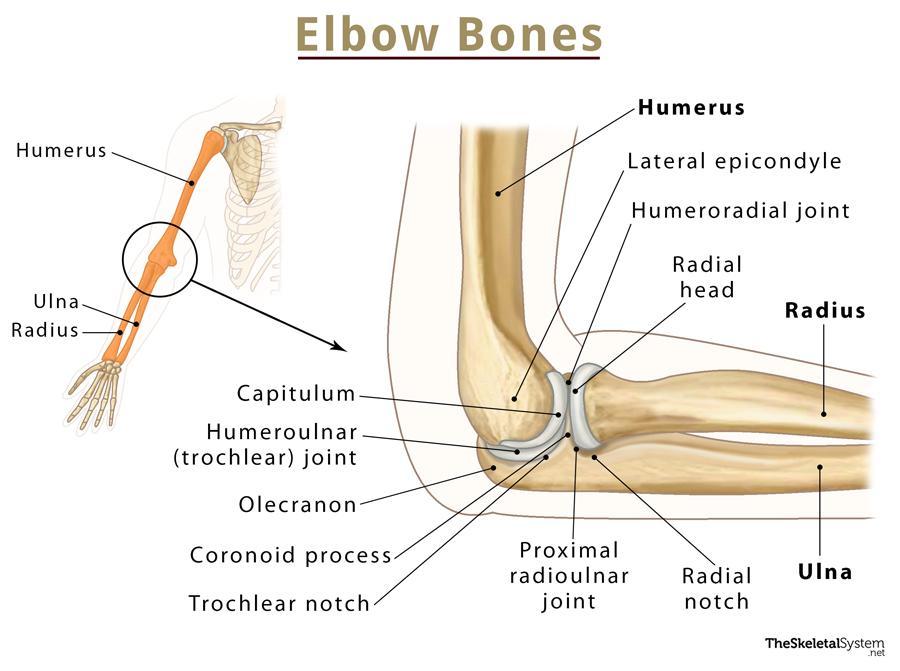Elbow Bones
The elbow is one of the most crucial hinge joints in the human body, consisting of multiple joints between the three arm bones in the region. The elbow allows all sorts of arm movement, allowing us to perform our daily activities.
Names of the Bones in the Elbow With Basic Anatomy
There are 3 bones involved in the elbow joint:
- Humerus: The bone extending from the shoulder down to the elbow
- Radius: The bone extending from the elbow towards the thumb-side of the forearm
- Ulna: The second forearm bone, running from the elbow to the side of the little finger
Joints and Articulations in the Elbow
The following three synovial joints form the elbow joint capsule:
- Humeroulnar (Trochlear) Joint: Between the humeral trochlea and the ulna’s trochlear notch
- Humeroradial Joint: Between the capitulum of the humerus and the radial head
- Proximal Radioulnar Joint: Between the head of the radius and the radial notch of the ulna
Only the first two articulations are included in the elbow joint. The proximal radioulnar joint is a separate articulation within the elbow joint capsule.
Protrusions and Bony Prominence
- Olecranon: The pointy bony structure at the posterior side of the elbow; it is the protrusion at the upper end of the ulna
- Lateral epicondyle: The bump above the elbow on the outer side of the arm; it is part of the distal end of the humerus.
- Medial epicondyle: The second bump that can be felt on the inner side, just above the elbow; it is also part of the humerus.
- Coronoid process: A triangular projection at the proximal end of the ulna; can’t be felt from outside
These bony landmarks serve as attachment points for all the ligaments and tendons essential to the elbow’s functioning.
Ligaments
- Ulnar/Medial collateral ligament: Attaches the humerus and ulna
- Radial/Lateral collateral ligament: Connects the humerus and radius
- Annular ligament: Holds the radius tightly against the ulna through a strong band of fibers around the radius’ head
- Quadrate ligament: Another connection between the radius and ulna
Muscles and Tendons
- Biceps
- Triceps
- Brachialis
- Wrist extensors
- Wrist flexors
The biceps and triceps tendons are the most important tendons in the elbow. Apart from these, the muscles responsible for straightening the wrist and fingers come together at the lateral epicondyle into a single tendon that attaches to the humerus.
Similarly, the muscles responsible for bending the wrist and fingers come together at the medial epicondyle, forming one tendon that attaches to the humerus.
Nerves
- Median nerve
- Musculocutaneous nerve
- Radial nerve
- Ulnar nerve
Functions of the Elbow Bones
The elbow can undergo three different movements, the first being the most obvious, where the bones and ligaments help flex and extend the forearm at the elbow joint (hinge action). This movement allows us to reach for objects, pick up heavy objects, and perform exercises like bicep curls.
The other two movements are less noticeable but equally important. The bony protrusions in the elbow bones serve as the attachment points for multiple important tendons involved with the movement of the wrist and fingers.
FAQs
Ans. The term ‘funny bone’ refers to the ulnar nerve rather than a specific bone. The ulnar nerve crosses the elbow as it travels from the neck to the fingers.
References
- The Anatomy of the Elbow – Ortho.wustl.edu
- Elbow Bones Anatomy, Diagram, and Functions – Healthline.com
- Elbow Anatomy – Arthritis.org
- The Elbow Joint – Teachmeanatomy.info
- Elbow Joint – Kenhub.com


